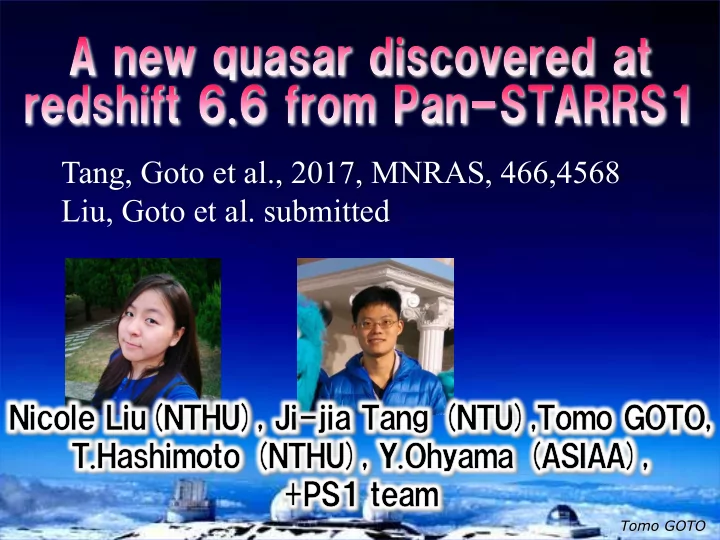

Tang, Goto et al., 2017, MNRAS, 466,4568 Liu, Goto et al. submitted Tomo GOTO
������� ������������ ������ ���� ��� ��� Tomo GOTO
When, and how the Universe was reionized? One of the outstanding questions in the observational cosmology.
������������������������� ��� neutral ionized ���� ����������� ������ �������� � �� � ������������������������������ Tomo GOTO
������������������ ����������� ��������������� ������� ����� ���������� ������ ���������������
��� ���� ������� ��� �������������������� ������������������������ �������������
���� ����� p ������ ������ ��� ����������������� � � ������ ���� �������������������������������������� ����������
����������������������������� Discovery spectra 5*1000sec 1 hour (Tang, Goto et al. 2017) R~600 ������������� ������ Tang, Goto et al., 2017, MNRAS, 466,4568
������� � ���������� �������
��������� Discovery spectra 1 hour (Tang, Goto et al. 2017) ����� SN~7 Follow up spectra ����������������� 7.5 hour (PI:GOTO) ������ SN~20! y~20.0mag
�� Ly α Nv z~5.2 z~5.6 z~6.0 z~6.4 z~6.6 (Ly α redshift) Spectrum: Later we will preform 3 methods to probe the phase evolution with the spectrum
���� ��� �������
������������������
Ly α Continuum Nv z~6.6 z~5.2 z~5.6 z~6.0 z~6.4 (Ly α redshift) Spectrum: Later we will preform 3 methods to probe the phase evolution with the spectrum
1. Transmission & Optical depth ()*+ ,-. Optical depth: " = − %& ' Transmission: ' = ()*+ /01 Transmission ������������� redshi redshi � ��� � ��� ft ft Method1: measuring the transmission and optical depth
2. Dark gaps statistics optical depth~2.5 5.27 5.58 5.89 6.21 6.52 Ly α redshift Lower Lower Higher transmission Higher Higher transmission transmission transmission transmission Observer, z=0 Quasar, z=6.6 (ionized) Method2: counting the gap span by two adjacent peaks
2. Dark gaps statistics median of the gap width z = 5.48-5.83 0.20 ŠNumber of the gaps 0.66 Šz = 5.83-6.18 0.80 Šz = 6.18-6.54 z>6.1 �� Gap width( Š) ��� Method2: The gaps size(neutral region) is larger at higher redshift
3. The dark pixel fraction dark pixel not dark pixel 5.74 5.91 6.07 6.23 6.40 Ly α redshift �������������� (neutral) � ����� No need to assume the intrinsic flux! Method3: dark fraction = upper limit of the neutral fraction
3. The dark pixel fraction Neutral fraction z>6.1 ����� Method3: dark fraction = upper limit of the neutral fraction
Three abs. tests up to z~6.6 1.Transmission: flux~0 at z>6 even with our high-quality spectrum. We found a 2. Dark gap distribution: bright QSO at A jump of gap width at z=6.6 5.8<z<6.2 3. Dark pixel fraction: Many thanks for your attention!
Recommend
More recommend